
A postmark with a story.
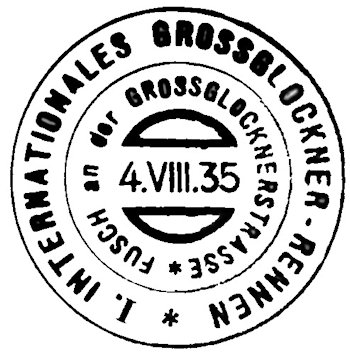 The Grossglockner, a mountain in Austria near Heiligenblut, is located on the border of Tyrol and Carinthia and is with 3798 meters the highest mountain in Austria. The highest point that is accessible for traffic, the Edelweissstrasse, is at 2571 meters height. Also by motorcycle or car a bit of a climb. The Grossglockner, a mountain in Austria near Heiligenblut, is located on the border of Tyrol and Carinthia and is with 3798 meters the highest mountain in Austria. The highest point that is accessible for traffic, the Edelweissstrasse, is at 2571 meters height. Also by motorcycle or car a bit of a climb.
For this reason already in 1935, 1 day after completion of the construction on August 4th, a hill climb race, in German "Bergrennen", had been organized there.
Bergrennen were already organized in many countries short after the invention of the car and the motorcycle. Already in 1899 the first races were held in Austria in Semmering. After the First World War motorsports resumed slowly, and a series of races was held with the title Grand Prix.
In Austria this became in 1929 "Der Grossen Bergpreise" of Austria on the Gaisberg near Salzburg.
In 1935 this event moved to the just newly built road to the top of Austrias highest mountain, the Grossglockner Hochalpenstrasse. The race to the top was held over a distance of 19.5 kilometers, with a difference in height of 1593 meters.
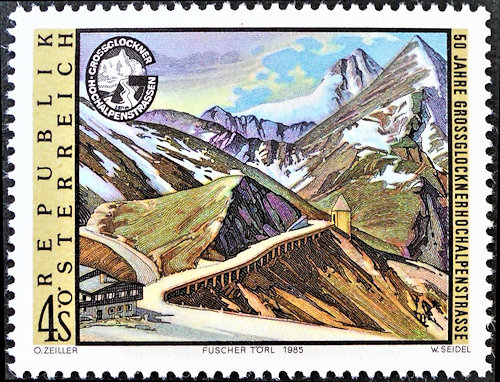
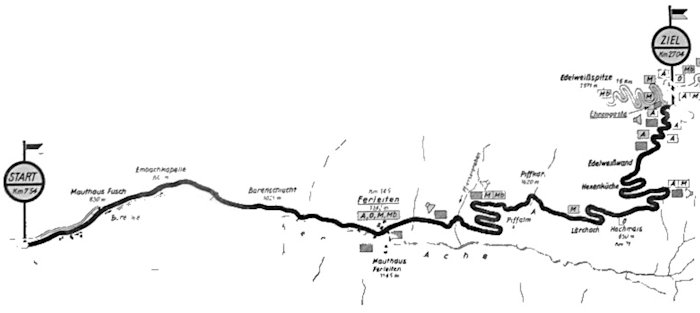
Off course the Austrian Post dedicated a remembrance postmark to this, however without image of a car or motorcycle.


Races were held with 250 cc, 350 cc, 500 cc, 1000 cc and sidecars with 600 cc engines. The car class counted 5 groups from 1100 to 3000 cc.
Two more times (1938 and 1939) there was a race on the
Grossglockner Hochalpenstrasse, but after the "Anschluss" in 1938 the name was changed into Grossen Berpreise of Germany.
Nowadays, as with many races from the past, the race is held again every 2 years as re-enactment, but now as regularity race.
On a block issue from the Caribian Dutch Saba with as theme "The Kingdom of the Netherlands in war 1940-1945" and as sub-title "Liberation of the Netherlands in 1945" there are a few well-known images. The issue consists of 24 (probably semi-) personalized stams.
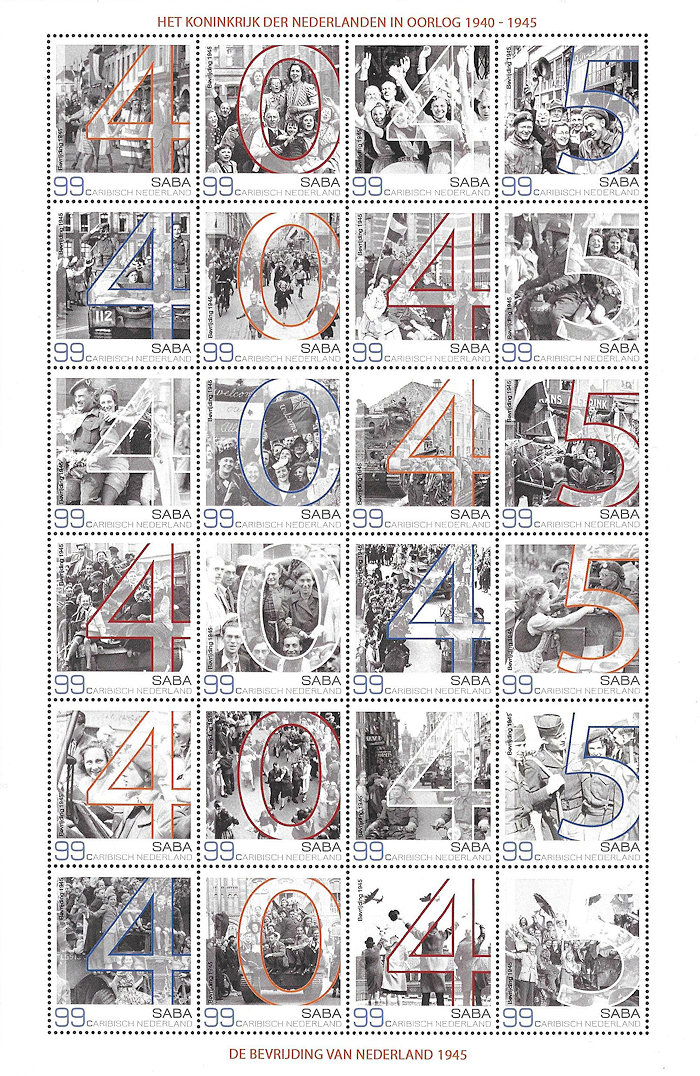
"Probably semi" because the stamp sheets, supplied by private post services from Saba, contain 10 identical images. But OK, when Nico showed me this discovery the 3 stamps with a motorcycle caught the eye immediately.
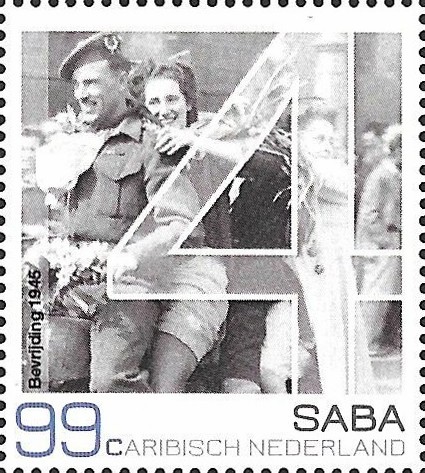
The first one shows the picture that has already been used for the issue "Dutch highlights from the 20th Century" (1999) from the Canadian W. Roberts, with a couple (3) nice young ladies on his pre-war Matchless GL3. You have to know it, otherwise you will easily overlook this one.
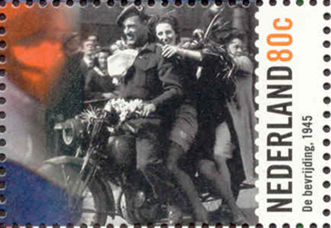
Then the second motorcycle stamp. This one shows 2 Canadian motorcycle riders in the Leidsestraat in Amsterdam. The right motorcycle has no black-out lighting, which indicates that this motorcycle had not been used at the front. But both motorcycles are also Matchless GL3 bikes. The picture comes from the NOS-website.
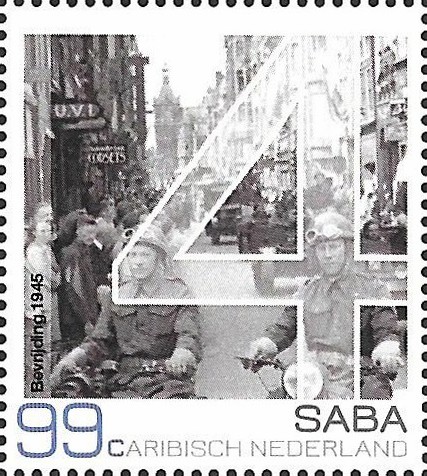
The third is also of a well-known picture from the liberation of Amsterdam and shows 2 girls at the back of again a Matchless GL3, but now from 1941 and with telescopic front forks. This model got an extra W (wartime) after the letters, and to give the girls somewhat more seating comfort a short piece of buddyseat was added. Off course this was intended for the soldier to enable him to ride in a low position over the battle-field.
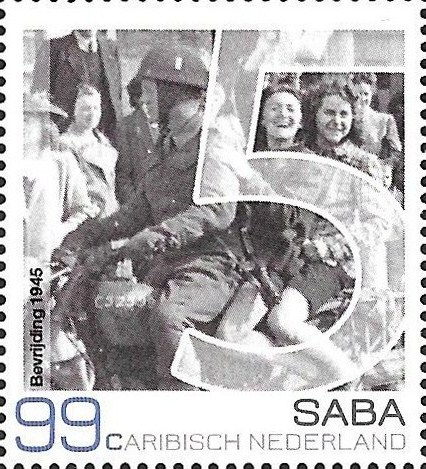
The value of all stamps is 99 cents and over each row of images are the numbers 4, 0, 4 and 5 which form horizontally 4045.
Sort it out!!
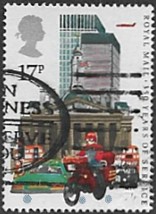 It is already quite a long time ago, perhaps even a few years, that I received from a club member an English stamp from the 350 years Royal Mail series with the data-rider depicted on it, that was provided with a number of pearly dots. The question was what kind of dots these were. I also did not have the faintest idea what and why this was. I searched for some time, but after that put it aside. It is already quite a long time ago, perhaps even a few years, that I received from a club member an English stamp from the 350 years Royal Mail series with the data-rider depicted on it, that was provided with a number of pearly dots. The question was what kind of dots these were. I also did not have the faintest idea what and why this was. I searched for some time, but after that put it aside.
Now, quite some time later, I found on internet a card with the same dots. With these images I could do a lot more because it was an introduction card for
A.L.S., Automatic Letter Sorting.
I have processed the image shown here a bit to make the dots better visible. In reality they are very light in colour and on written and
well-thumbed envelops they are difficult to recognise. So it is clear that this concerns automated reading/sorting indications.

Already in 1931 the Transorma letter sorting machine was used in Rotterdam, a Dutch invention that spread over many postal services in the world (see NB 98 for the article about this from Nico). However, for many zip codes this machine was not the best solution, and therefore the development departments of the concerned postal services experimented with own systems. In the eastern part of Europe the OCR method was tested, which tried to read letters and numbers that were written in a certain fixed way. See the Russian envelops.

In England, were a zip code consisting of 3 + 3 characters is used, the modified Transorma method was used with the address converted into two lines with each 1 letter and a number of phosphorescent points, the dots. The lower line represented the district where the letter should be sent to, and the upper one the district and address of the receiver. When the stamp was not placed exactly on the right spot, it could off course happen that such a dot ended on the stamp.
The test sorting center was located in Milton Keynes, and look which name is on the postmarks. And the testing phase started in 1985 and was stopped in 1986. Thus it can be that you can find a stamp with the data-rider in your collection. Success with your search!
Hans de Kloet
Top - Back to former page - Home |